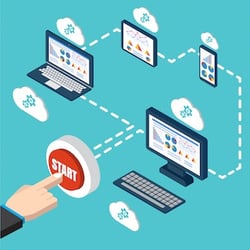 Although the Lean approach to business management was originally developed for, and deployed in the manufacturing sector, it has become widely adopted in industries of all types. Why? Because the principles of lean define a business methodology that makes sense in everything from hospitals to software companies.
Although the Lean approach to business management was originally developed for, and deployed in the manufacturing sector, it has become widely adopted in industries of all types. Why? Because the principles of lean define a business methodology that makes sense in everything from hospitals to software companies.
But principles alone do not create change. They must be supported by a culture that embraces them and the tools to execute effectively. Improvement software is one such tool that can make all the difference in an organization that is ready to gain the benefits of sustained improvement.
Principle #1 – Value as Seen by The Customer
As Lean practitioners, we do not define the value of our product. Our customers do. If a customer is not willing to pay for a certain product, service, or feature, it has no value. Therefore, every effort is made to align everything we offer with things that customers care about.
Improvement software has an important role to play in terms of delivering value to customers. It provides a platform for capturing ideas for improvement from employees and customers alike. It also allows for assessing key metrics that indicate customer value, such as sales results and customer satisfaction scores. Each opportunity for improvement that is implemented can be measured by its impact on customer value.
Principle #2 – The Value Stream
The value stream includes the set of processes, activities, and materials required to create value and get it in the hands of the customer. Anything that doesn’t add value to the customer does not belong in the value stream. Lean organizations are obsessive about understanding the value stream and identifying eight distinct types of waste.
Technology can support efforts to perfect the value stream in a number of ways. Value stream mapping software helps teams document and analyze each process and all of the Standard Work that makes up the stream.
Principle #3 – Flow
The value stream should flow easily from raw materials to the customer. There should be nothing that creates a barrier to delivering value efficiently. Ensuring a smooth flow means careful coordination across processes and departments.
The most effective Lean organizations use improvement software to make it easy for leaders to recognize and respond to issues that block flow. Employees can easily report challenges and cross-functional teams can be spun up to address them. Alerts and notifications ensure that everyone does what it takes to solve problems quickly.
Principle #4 – Pull
The Lean principle of Pull is the antidote to several of the wastes of Lean including: inventory, waiting, movement, and transport. It dictates that nothing is produced until it is needed. This eliminates excess work-in-progress inventory. Whether that “inventory” is a physical product, software code, patients in a waiting room, or something else, the principle of Pull can still be applied. Customer actions dictate the speed at which value is produced, not forecasts or quotas.
The idea of Pull also applies to improvement projects. Smart organizations limit the number of active projects and begin new ones only when the team is ready to act. Electronic Huddle Boards are a great way for leaders to visualize the status of improvement projects and use the principle of pull to guide decisions about which, and how many opportunities are addressed.
Principle #5 – The Quest for Perfection
Lean thinkers know that perfection is impossible, that’s why improvement must be continuous, but they strive for it anyway. Perfection means more than simply getting the job done. It means getting it done with as little waste as possible while adding the maximum amount of value. It means looking for the true cause of any problem, rather than just applying a quick fix. It means performing each process consistently and according to the best practice.
Improvement software isn’t a guarantee of perfection, but achieving anything close without supporting technology is difficult. Improvement applications create a repository where critical information, such as Standard Work documentation is stored. It supports improvement cycles like PDSA, DMAIC, and rapid improvement events, along with problem-solving techniques such as the 5 Whys and A3.
Any organization can adopt the principles of Lean, but those that are serious about running the business according to them realize that adopting principles alone is not enough. With the right software solution, those principles become part of how the business operates on a daily basis. They remain top of mind for employees and guide every decision. That’s how to achieve maximum business impact.
![The 7 Wastes of Lean [Free eBook]](https://no-cache.hubspot.com/cta/default/326641/b3d32e45-87f5-4557-865f-772d99911733.png)


Add a Comment